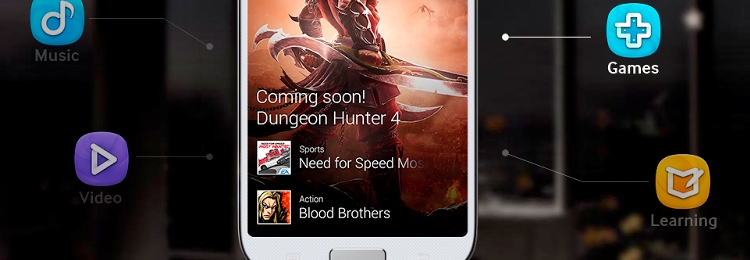Software, UI, Apps and Browser
Software and User Interface
Though the Galaxy S 4 aesthetically looks just like every other Samsung smartphone released in the past 12 months, that familiar face masks that there's a seriously upgraded brain beneath it. Take the notification panel that previous versions of Touchwiz have used to provide shortcuts to common features. Those shortcuts can now be rearranged based on the importance and frequency that they are accessed.
Multi-window was introduced as a way to run two apps on a split screen of Galaxy tablets, but the feature is more mature and still useful on the 5-inch screen of the Galaxy S 4. The number of apps, including those developed by third parties, able to run in Multi-window has grown significantly, so users can check YouTube and Twitter simultaneously just as easily as they were previously able to use Gmail and the browser.
The Android 4.2-powered Galaxy S 4 has more features than users will ever care to learn or use. The sensor-based software seems counterintuitive at first, but parts of it actually end up having practical value. Air Gesture is a way to navigate by not actually touching the screen; swipe above a sensor and the phone will know to go to the next image in the Gallery. It's much easier and faster to swipe by touching the screen, so nothing's really gained in that instance. That doesn't mean Air Gesture is useless; it's actually quite useful when swiping over an incoming call notification and automatically going into Speaker mode. Air View also has its limited practicality, but it comes in handy when previewing emails or navigating in media apps.
The Galaxy S 4 is full of such unnecessary but perhaps enhancing features. Group Play creates a shared network between devices in order to play the same song or even act as a makeshift Surround Sound system, which sounds especially pointless when one considers that it currently works only with other Samsung Galaxy S 4 devices. Smart rotation measures the angle of a user's sightline to know whether to show portrait or landscape, and Smart pause will know to pause video when someone turns away from the screen.

The trouble with the Smart features is that they are hit or miss. Some do not work when there's light behind the subject or in a dark area, and others don't work when Multi window is active. The fascination and cool factor of these apps are diminished by their unreliability.
Apps
Samsung poured resources into improving its built-in apps with small refinements that make a noticeable difference. The biggest impact is seen in the Email app, but small UI or feature changes improve Calendar and S Memo. The Contacts app hasn't been treated to a visual upgrade, but it does have new Speed Dial options.
The most interesting enhanced app isn't even developed by Samsung. Reading app Flipboard created a version of the app built specifically for Samsung products that supports Air View, so hovering over a section reveals a preview of the articles featured in that section. Samsung worked with Flipboard to enable the feature, so that naturally leads to wondering about what other apps might someday be able to support Air View - I'm looking at you, YouTube and every other media player or gallery app - if Samsung releases an SDK (Samsung informed us that it plans to work with more developers to implement Air View but declined to say if it will launch an SDK).

Samsung has included several new apps to accompany the Galaxy S 4. Media gets a big boost with Watch On, a TV-guide-like app that makes show discovery and tracking easier with information from Peel and an IR component that can control a television. Anyone with a Samsung Smart TV 2013 model gets the added bonus of being able to stream their television directly to their smartphone over Wi-Fi.
WatchOn is easily one of the Galaxy S 4's best features, but its limitation to certain TVs will likely exclude most users from ever putting the streaming function into practice. Other preloaded apps include Dropbox, Lookout Security, Polaris Office 5, Scout (Telenav), Trip Advisor, and four Sprint apps. The roster of bloatware will vary depending on carrier. There's also a Samsung keyboard with SwiftKey integration, but it's not very good, so spend the money and buy the actual SwiftKey app instead. Swype is included as a secondary input option.
Browser
Chrome be damned, Samsung is sticking to its own implementation of the Internet app. The strategy is actually favorable because Internet has baked in support for Adobe Flash, something Chrome cannot do on Android Jelly Bean. Yes, much of the web is moving to HTML5, but the transition isn't happening nearly fast enough to pretend like having the option to view Flash content isn't something to be praised.

The browser app also lets users set custom brightness levels, switch between Desktop and Mobile views, browse in private mode, and switch between tabs. The combination of software enhancements and a quad-core processor lead to some impressive benchmark scores that show Internet is as responsive as it is feature-rich. The only negative things I can say are that it could use a Full-screen option and the Lumen toolbar at the bottom of the screen is incredibly annoying. Thankfully, the latter can be removed from the Lumen settings menu.
